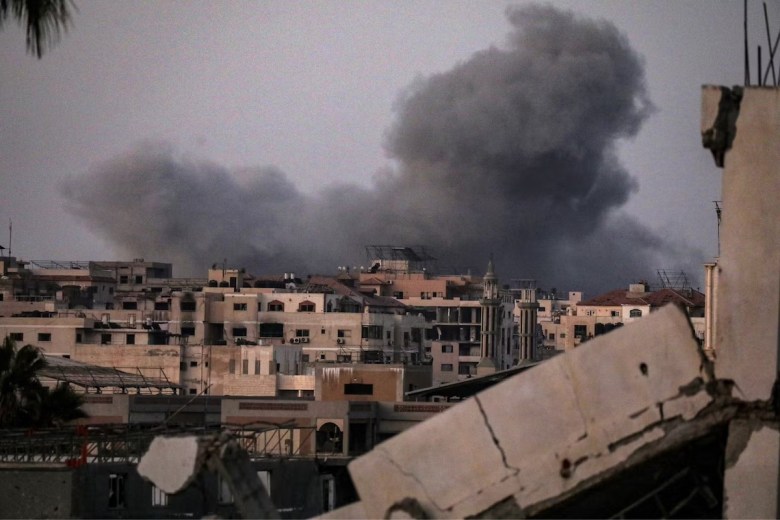Politics
Trump Proposes Comprehensive Gaza Peace Plan Amid Tensions

The United States has unveiled a comprehensive 20-point peace plan aimed at resolving the ongoing conflict in Gaza, with significant participation from Israel. This initiative marks one of the most detailed frameworks proposed by the Trump administration to address the situation involving Hamas. The plan reportedly enjoys support from several Arab states as well as the United Kingdom and France, potentially paving the way for a resolution to the hostilities that have plagued the region.
While the plan offers a detailed outline, it notably excludes Hamas from its development process. The militant group has not yet provided an official response but is reportedly reviewing the details. Complicating matters, Israeli Prime Minister Benjamin Netanyahu has stated that Israel will “forcibly resist” the establishment of a Palestinian state, seemingly contradicting the principles of the plan he has endorsed.
Key elements of the proposal include an immediate cessation of hostilities and the release of nearly 2,000 Palestinian prisoners, among them 1,700 Gazans detained since 2023. Furthermore, Hamas members who disarm and agree to coexist peacefully with Israel will receive amnesty and the option to leave if they choose. The plan stipulates that Israel will not annex or “occupy” Gaza, although it establishes a security perimeter around the enclave, leaving the timeline for troop withdrawal unclear.
Humanitarian aid is a focal point of the proposal, which aims to restore critical support for civilians. It acknowledges the pivotal role of the United Nations and the Red Crescent in administering this aid, marking a significant concession. Importantly, the plan emphasizes that no one will be forced to leave Gaza; instead, it encourages residents to remain, while also allowing those who wish to leave the freedom to return.
Despite these provisions, Hamas is likely to perceive numerous challenges within the plan. While some leaders within the organization have previously indicated a willingness to consider phased disarmament, the prospect of full disarmament poses significant difficulties. Many regions of Gaza, along with other parts of Palestine, remain under Israeli control, and Hamas will likely seek clearer timelines for Israeli Defense Forces (IDF) withdrawal before agreeing to any public disarmament.
The plan also falls short of providing guarantees that hostilities will not resume following the release of hostages. According to the outline, hostilities will cease upon signing the agreement, followed by a 72-hour period designated for the release of all hostages. Hamas is expected to demand further assurances from the United States and regional partners that renewed conflict will not erupt once hostages are returned.
Additionally, the governance structure proposed in the plan raises concerns for Hamas. It suggests a two-tiered model where a technocratic Palestinian committee would manage daily services, overseen by a new international transitional body led by Donald Trump alongside other prominent figures such as Tony Blair. Blair’s previous tenure as Prime Minister and his role in the Quartet mediating the Israel-Palestine peace process have made him a controversial figure among Palestinians, raising questions about the acceptability of this governance model.
The future role of the Palestinian Authority (PA) in governing Gaza remains contentious. The plan states that the PA will not assume governance until it has completed a reform process outlined in Trump’s earlier proposals. However, Netanyahu has explicitly rejected any role for the PA in Gaza’s future, further complicating the landscape.
The proposal is also vague regarding Palestinian statehood, acknowledging the aspiration for self-determination without outlining a clear path forward. Netanyahu has made it clear that he will resist any initiatives aimed at advancing Palestinian statehood, leaving a significant void in the negotiations.
As the people of Gaza continue to endure tremendous hardships, it is clear that Trump’s plan, despite its flaws, may represent the best opportunity Hamas will receive from the United States and Israel. The critical question remains whether the involved parties are willing to address the existing obstacles or whether they will use any objections as justification to prolong the conflict.
Julie M. Norman, a senior associate fellow on the Middle East at RUSI and an associate professor in politics and international relations at UCL, provides insights into the complexities surrounding the proposal. The future of Gaza hangs in the balance as stakeholders consider their next steps in this challenging geopolitical landscape.
-

 Business5 months ago
Business5 months agoKenvue Dismisses CEO Thibaut Mongon as Strategic Review Advances
-

 Lifestyle4 months ago
Lifestyle4 months agoHumanism Camp Engages 250 Youths in Summer Fest 2025
-

 Sports4 months ago
Sports4 months agoDe Minaur Triumphs at Washington Open After Thrilling Comeback
-

 Sports5 months ago
Sports5 months agoTupou and Daugunu Join First Nations Squad for Lions Clash
-

 Top Stories5 months ago
Top Stories5 months agoColombian Senator Miguel Uribe Shows Signs of Recovery After Attack
-

 World5 months ago
World5 months agoASEAN Gears Up for Historic Joint Meeting of Foreign and Economic Ministers
-

 Health4 months ago
Health4 months agoNew Study Challenges Assumptions About Aging and Inflammation
-

 Business5 months ago
Business5 months agoOil Prices Surge Following New EU Sanctions on Russia
-

 Entertainment4 months ago
Entertainment4 months agoDetaşe-Sabah Violin Ensemble Captivates at Gabala Music Festival
-

 Entertainment4 months ago
Entertainment4 months agoBaku Metro Extends Hours for Justin Timberlake Concert
-

 Top Stories5 months ago
Top Stories5 months agoRethinking Singapore’s F&B Regulations Amid Business Closures
-

 Business5 months ago
Business5 months agoU.S. House Approves Stablecoin Bill, Sends to Trump for Signature









